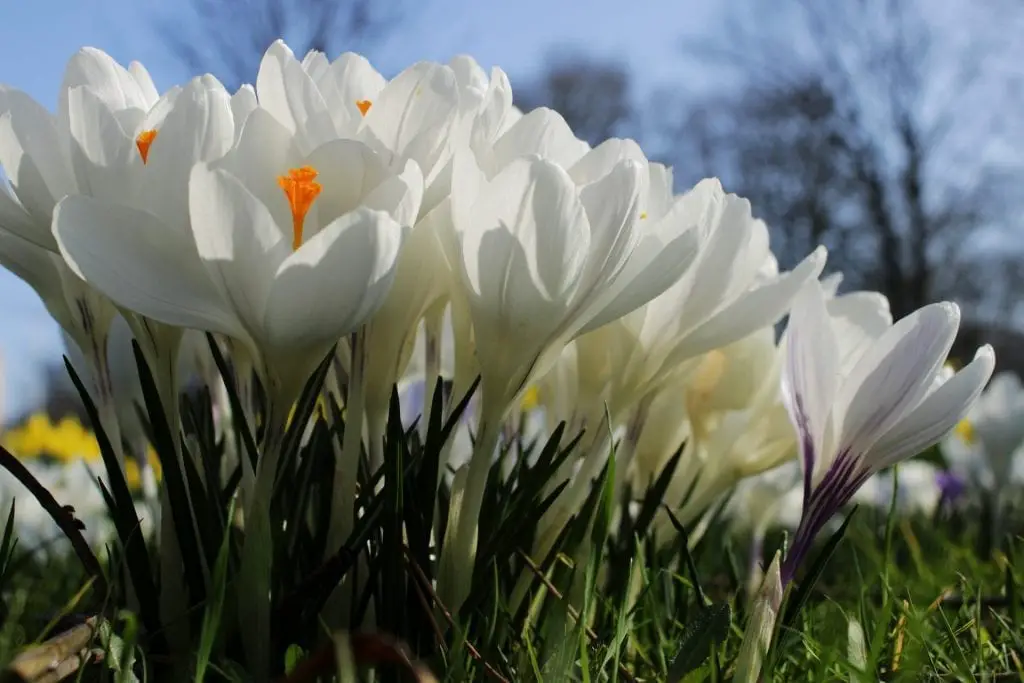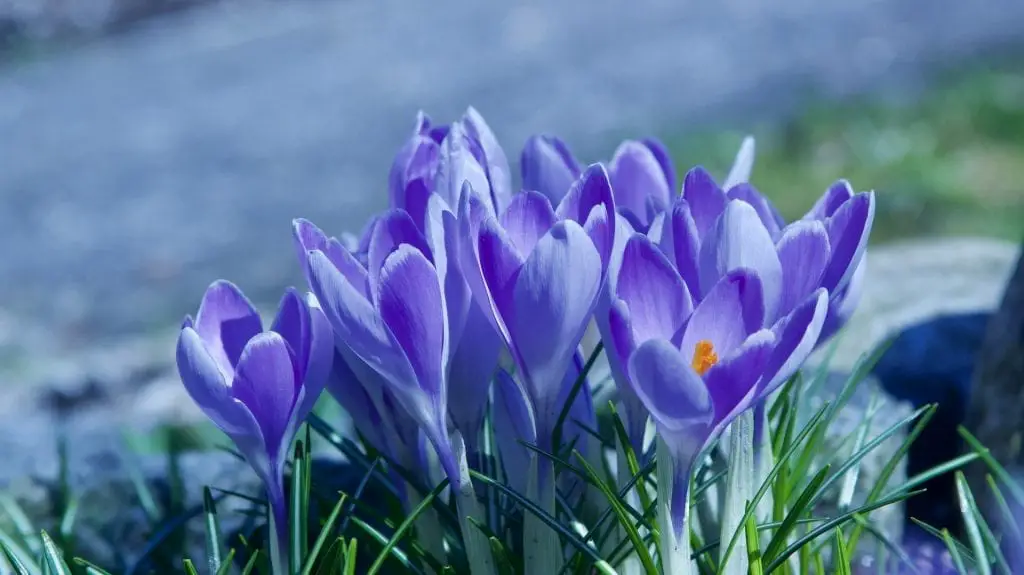
Last updated on May 20th, 2023 at 09:57 pm
There are more than eighty known species and cultivars of the crocus flower. Crocuses have a wide geographical spread—they grow in diverse locations, from Central Europe to the Middle East to Central Asia and Africa. Crocuses are perennial plants. Most crocuses bloom in late winter/early spring, but there are a few autumn varieties.
Crocuses are dwarf and bulbous plants. The flowers are chalice-shaped and long-tubed, with prominent stamens and stigmas. Most crocus varieties are fragrant flowers. They are sometimes called the light bulb of the garden. The dark-green leaves of the plant are long and thin, resembling grass blades.
In many cultures, the crocus flower is a messenger of spring and a symbol of floral resurrection. Spring crocuses are the first flowers to sprout and blossom before the last layer of snow has gone.
The word crocus is derived from the Greek Κρόκος, translated as saffron. The Latin version of the name is crocatus. Other sources claim that the word crocus is of Middle Eastern origin. It could mean a fiber (a reference to the long stamens of the flower) or a thread (due to the use of saffron as a textile dye).
The root of the word crocus is traced to several words in other languages, including the Arabic kurkum, Aramaic kurkuma, Hebrew karkōm, and Sanskrit kunkumam.
The most eccentric etymological hypothesis links the words crocus and crocodile. Thomas Fuller, a seventeenth-century social historian, wrote of the saffron crocus and crocodiles. ‘In a word, the sovereign power of saffron is plainly proved by the antipathy of the crocodiles thereunto. Crocodile’s tears are never true, save when he is forced where saffron growth (whence he hath his name χροχό-δειλος or the saffron-fearer),’ concluded Fuller.
What does the Crocus flower symbolize?
Many flowers are emblems of gods and heroes. The crocus flower’s symbol is also seen in folklore and spiritual traditions worldwide.
In Greek mythology, Crocus (Κρόκος) was a mortal young man from Sparta who fell in love with the nymph Smilax. While there are several variations of the myth, none is a story with a happy ending. One version tells that, after her initial infatuation with Crocus, Smilax became tired of him and cast a spell, thus turning him into a crocus flower. The saffron Crocus has distinctive orange stigmas, which symbolize Crocus’ everlasting and unrequited love for Smilax.
In another version of the myth, Crocus avoided Smilax, causing her despair. When Aphrodite saw the pitiful state of Smilax, she turned her into a bindweed. There is yet a third version of the myth, according to which Crocus was heartbroken after the death of Smilax. Both the lovers were then turned into flowers.
Finally, there is a version of the myth according to which Crocus committed suicide after the gods forbade them to marry Smilax. Flora, the goddess of plants, turned the lovers into flowers. Following the tradition, Greeks placed Crocus and smilax flowers in their wedding bouquets.
A different legend tells of Crocus being a lover and companion of the Olympian god Hermes, a protector of merchants, travelers, and thieves. During a game of discus, Hermes accidentally killed Crocus. The death of Crocus had a devastating effect on Hermes, who then decided to turn his lover’s body into a crocus flower.
In the animistic Pagan religion, the Crocus remains the sacred flower of Hermes. Receiving a crocus flower is a subtle sign that Hermes has visited or contacted the adept.
There is another beautiful myth about the origin of the crocus flower. The story goes that on a beautiful day, Zeus and Hera lay embraced at a river bank. So passionate was their love that multitudes of crocus flowers suddenly sprung around them. This legend immortalized the crocus as a symbol of passionate love and divine alchemy.
Crocus is considered a powerful herb in plant witchery. The saffron variety is used in spells for love, wealth, and abundance. When saffron-laced food is imbued with love vibrations, it ignites reciprocal feelings in the person who consumes it. It is also said that saffron possesses the ability to connect to the energy of the Moon.
The crocus is sometimes associated with the goddess Eos or Aurora (the Goddess of the Dawn) because the flower closes at night and opens up at dawn. Dried crocus flowers kept in a sachet are used as love charms.
The crocus is also a magic ritual herb of Imbolc and Ostara spring festivals. Crocuses are emblematic of Persephone, the Goddess of the underworld; Like Persephone, the crocuses, too, emerge from the underground when spring arrives.
Dreams of saffron flowers reveal those aspects of our lives which demand immediate resolution. Dried crocus flowers put under the pillow are a magical cure for nightmares. Powdered and sprinkled around the house, they bring peace and blessings to the household.
The Greek enchantress Medea used saffron to seduce Jason. According to Homer, the fragrant love couch of Jove and Juno was decorated with crocus flowers.
In ancient India, the newlywed couple’s bed was covered with crocus flowers to ensure a harmonious relationship and long-lasting love.
In the Victorian tradition, the crocus flower also meant ‘do not abuse.’ The crocus was seen as a flower that brings forth a ‘cooling energy’ to soothe intense emotional outbursts and protect victims of domestic violence.
Since most crocus varieties bloom around Valentine’s Day, some sources associate the flower with this holiday of romantic love.
There is a more direct link between the crocus flower and St. Valentine, the third-century Roman saint. The story goes that the saint once treated a blind young girl using herbal ointments. The girl grew fond of the saint, and they often went for walks in the field. The girl plucked crocus flowers during these walks, making bouquets for her father. When St. Valentine was jailed and sentenced to death, he sent a letter to the blind girl containing a pressed yellow crocus.
As soon as the girl opened the letter, she could suddenly see. Since this happened on February 14, crocus became associated with Valentine’s Day.
In the Middle Ages, the saffron crocus symbolized merriment, cheerfulness, gladness, and the spirit of hope. Healers prescribed saffron as a flower that brings joy and happiness. The saffron crocus was seen as a flower of spring. Through the principle of imitative magic, some believed that consuming the flower could also end a period of depression or a night of the soul.
Although rarely, the crocus flower has also had some less favorable connotations. Some historical narratives from India described saffron as a ‘robe of death.’ A crocus flower that blooms on the grave of a loved person was seen as a good omen in the Far East. An Austrian superstition warns against picking crocuses to prevent bad luck and losing strength.
All in all, the crocus flower symbolic meanings are:
- cheerfulness
- happiness
- rebirth
- youthfulness
- vitality
- joy
- hope
Meaning of the Crocus flower colors
White color
Like most white flowers, the white crocus is a symbol of truth, purity, innocence, and sincerity. This flower also represents honesty and childlike purity. It also stands for baptism, rebirth, and new beginnings.

Purple color
Purple is traditionally a color of royalty, nobility, spirituality, mystery, and magic. Consequently, the purple crocus stands for all these qualities. It is also a symbol of success, pride, dignity, merriment, hope, and youthfulness.

Blue color
The blue crocus is a flower of sadness, melancholy, and nostalgia for the days bygone. This flower also means dejection and disheartenment and conveys that the best days have passed.

Yellow color
The yellow crocus symbolizes youthfulness, vitality, joy, happiness, and hope. The meaning is drawn from the yellow-golden rays of the sun and the symbolic dispelling of the darkness of the winter days. The yellow crocus is the flower of cheerfulness, optimism, resilience, and regeneration.

Interesting facts about the Crocus flowers
- Crocuses are the first flowers to bloom in the spring. They poke out of the snow and bring cheer to a colorless landscape.
- Crocus bulbs are part of a special culinary recipe. During the annual spring festival, Hıdırellez is celebrated in Turkey on the 6th of May; people make a traditional pilaf dish with rice, wheat, and crocus bulbs. This is an old tradition with origins back to Ancient Anatolia, 2000 B.C.
- All parts of the autumn crocus are poisonous except for the stamen. It is also poisonous for pets. It can cause bloody diarrhea, drooling, and vomiting. In extreme cases, it can cause death.
- A folklore tradition says that the flowers a girl picks in spring will reveal the name of her future husband. Picking crocuses was a sign that he would contain the letter C in his initials.
- Ancient Egyptians decorated their chalices with crocus flowers while drinking wine. The act symbolized joyful celebration. Historical artifacts dating back to 1600 B.C. show that Egyptians were fond of crocuses.
- Throughout human history, many healers believed in the health benefits of crocus. For example, it was once believed that eating crocus seeds could relieve rheumatic pain in England. People in Ireland believed that rinsing bed linen with saffron crocus would strengthen the arms and legs.
How to grow Crocus flowers
Crocus is one of the most common early spring bloomers. They can add color to your lawn, whether you plant them in a formal group or use them to naturalize them. These plants will last a lifetime with proper crocus flower care.
- Plant the crocus in well-draining soil.
- Place the plant in a spot with full sun for 6+ hours of direct sunlight.
- Apply a balanced fertilizer.
- Water the plants when the weather gets dry.
- Cover the beds with mulch before the winter.
How to care for Crocus flowers
- Give the crocus some light watering in the spring or when it hasn’t rained for three to five days.
- Crocuses don’t need to be fed; however, mulching a border around them will be beneficial.
- Don’t remove the foliage once the crocuses have flowered.
- Remove it after it has entirely withered and become yellow.
Best time to gift Crocus flowers
Their color symbolism is very important when choosing crocus flowers as a gift.
Signifying achievement and pride, the purple crocus can be a thoughtful gift to a friend on the occasion of a job promotion, business success, or public recognition.
A bouquet of blue crocus flowers is a soulful encouragement gift for a friend going through a difficult phase in life.
Yellow crocuses carry the spirit of youthfulness, energy, and joy and are a wonderful way to cheer up a colleague, friend, or romantic partner.
White crocus flowers are a suitable felicitation gift for the birth of a child or a baptism.
And finally, as symbols of passionate and romantic love, all crocus flowers can convey the most intimate feelings of the heart.
Conclusion
Now that you know what the different colors of the crocus flower symbolize, pick the right color to give as a gift. These are easy to grow in a landscape or even in a pot.
In cold regions, it can be considered a perennial as they bloom in the spring and fall. If the person you want to give crocus flowers to doesn’t have a garden, buy bulbs and plant them in a ceramic container. These corms are easy to grow and care for.
These beautiful and colorful flowers make a good gift any time of year and are appropriate for most occasions.
If you want to know and learn more about flowers, we at PansyMaiden can help you. Check out our fun, easy-to-read, and informative flower-related content that you will surely enjoy!
